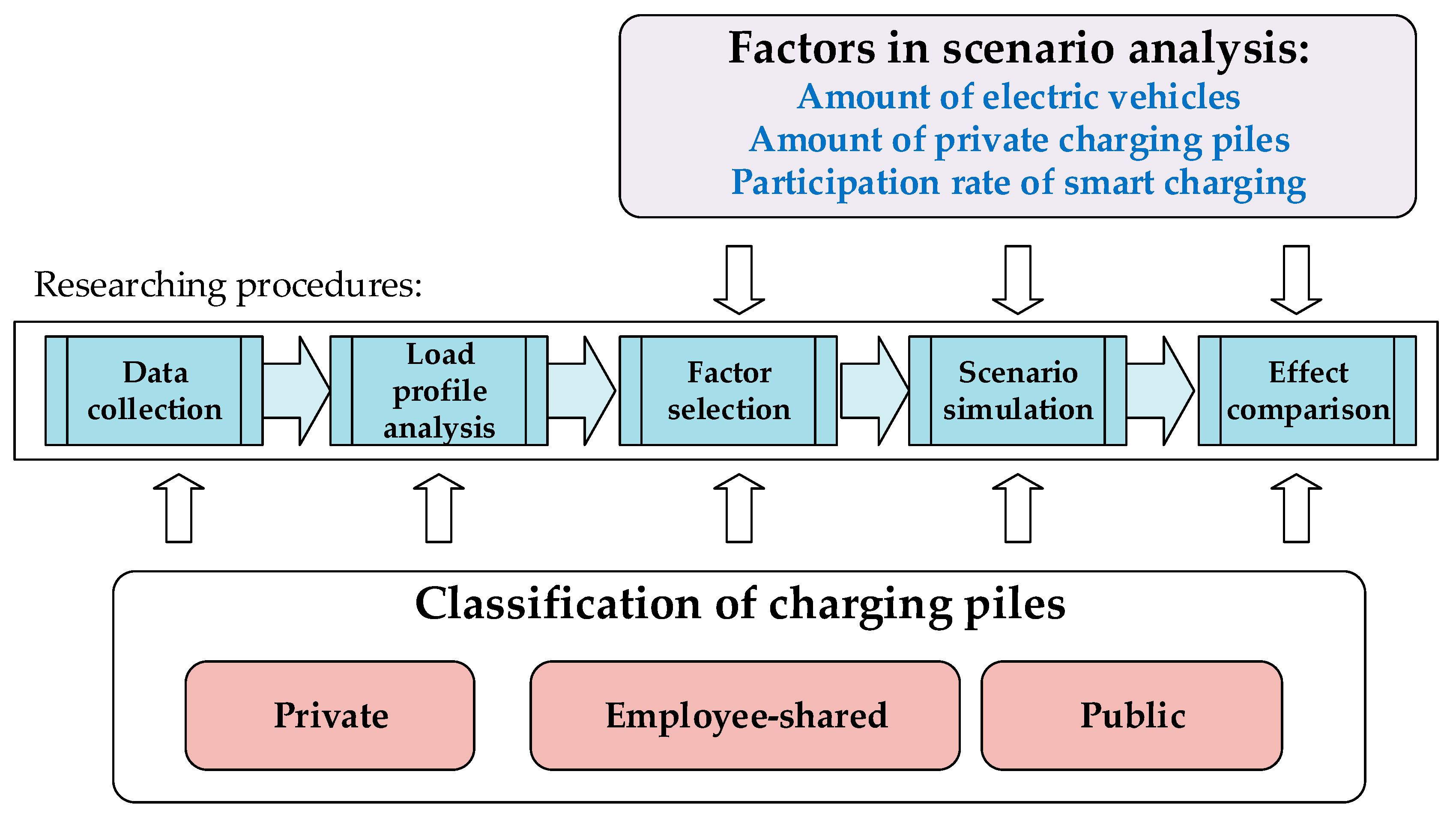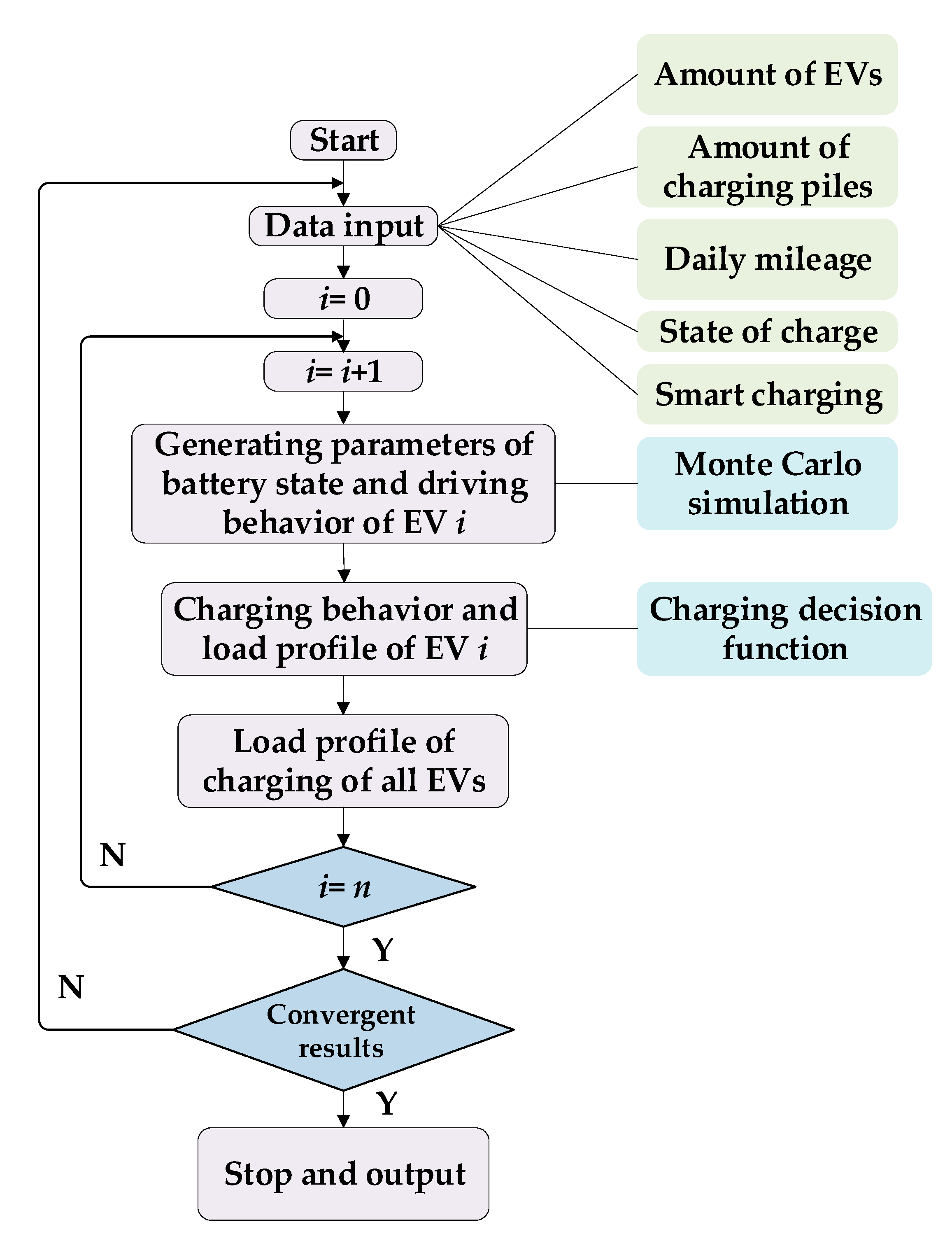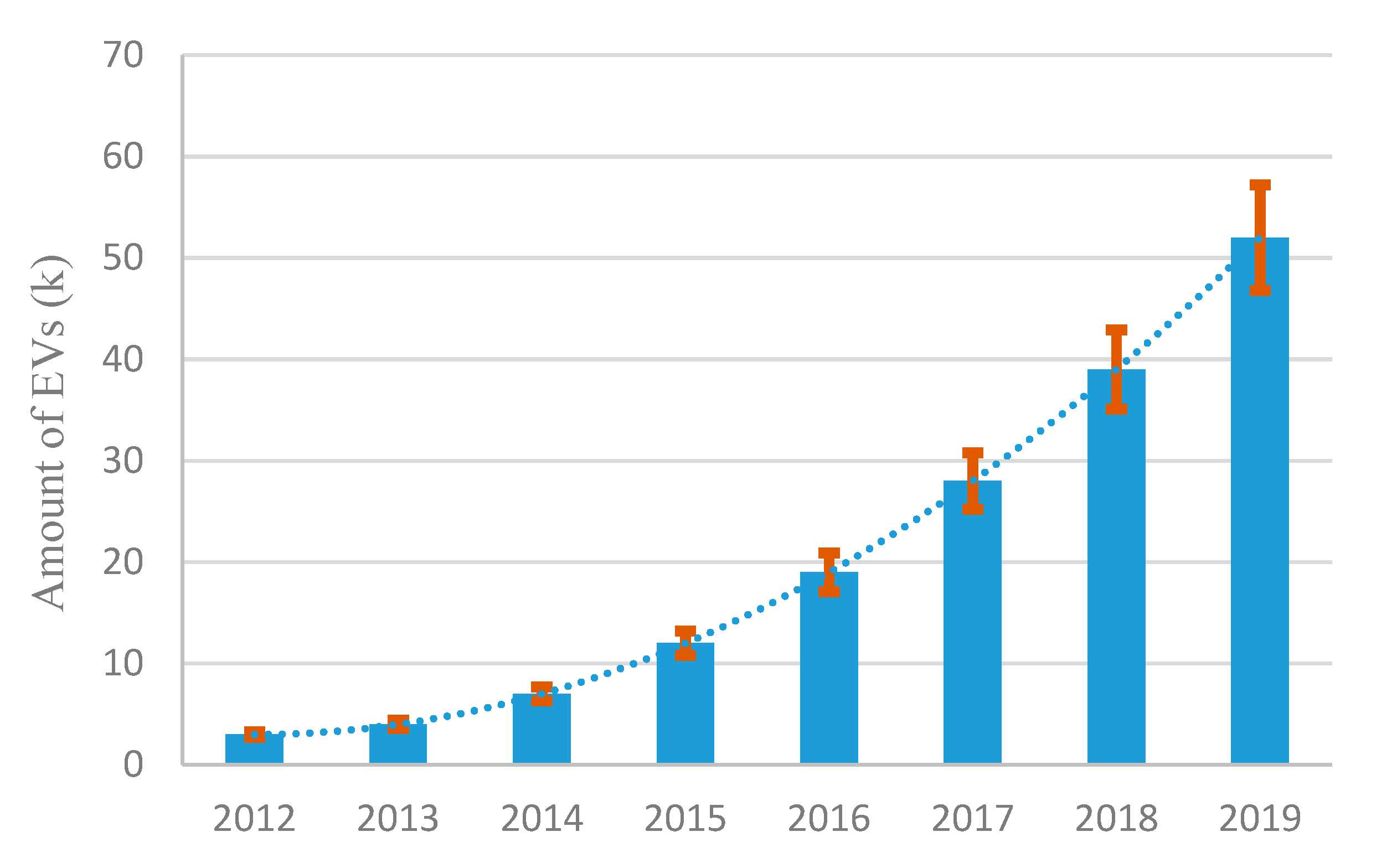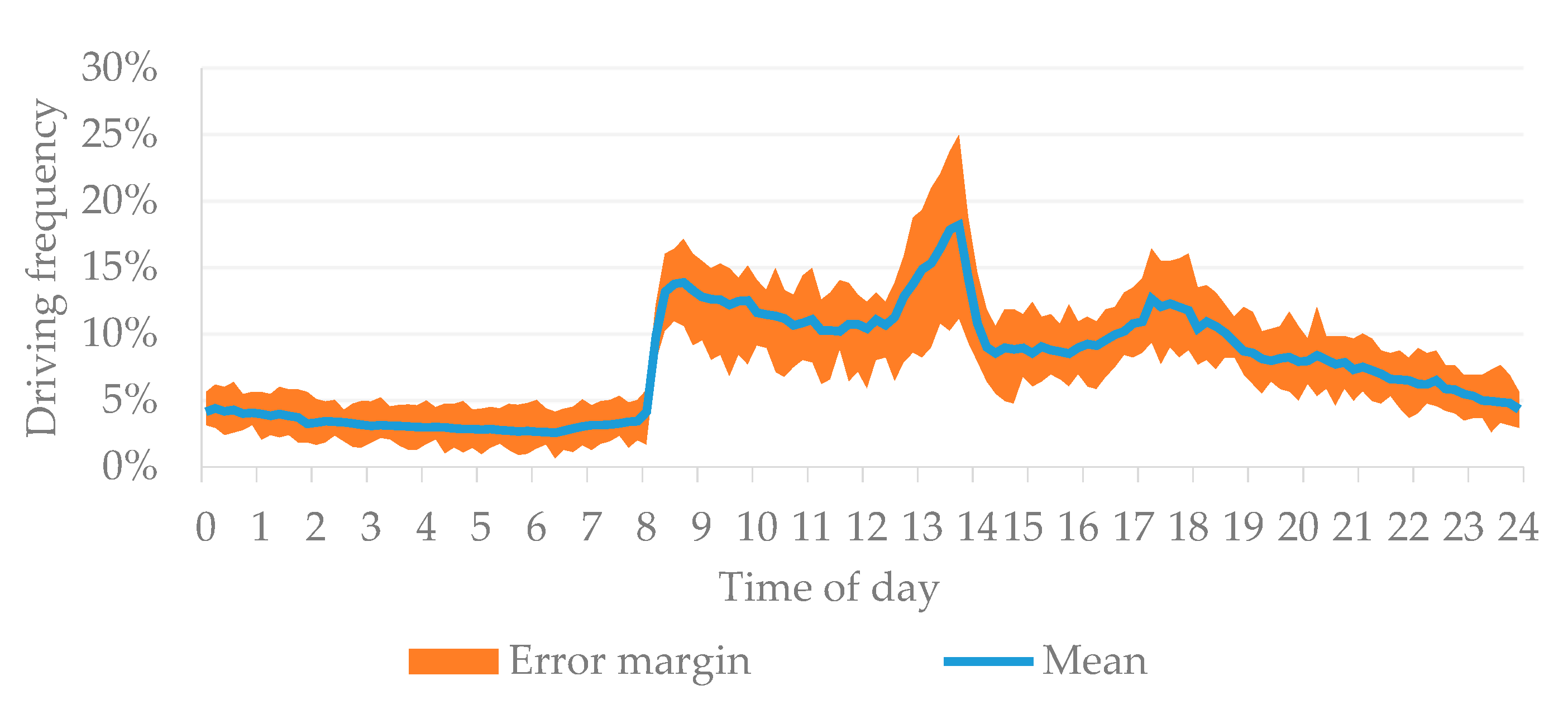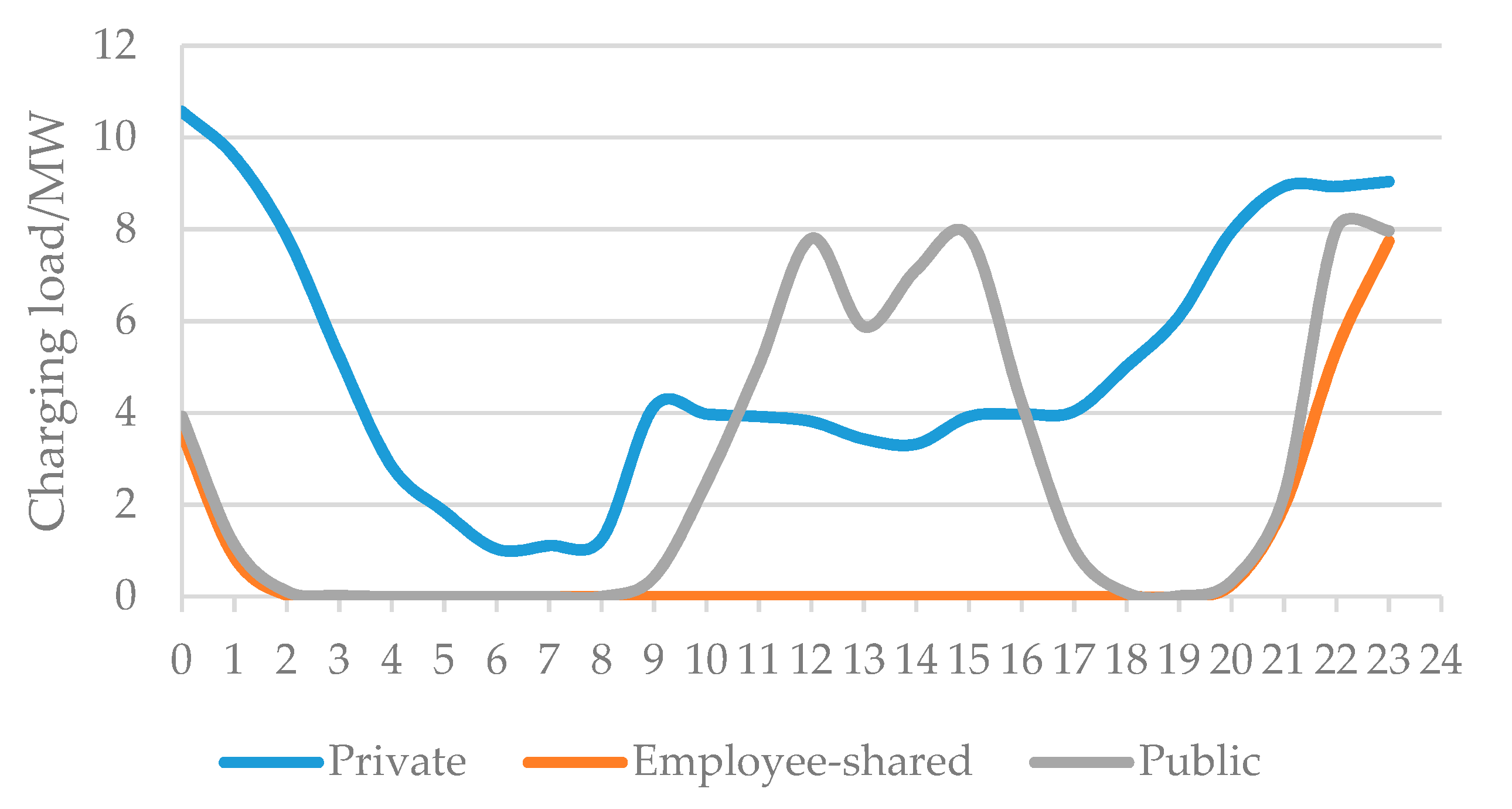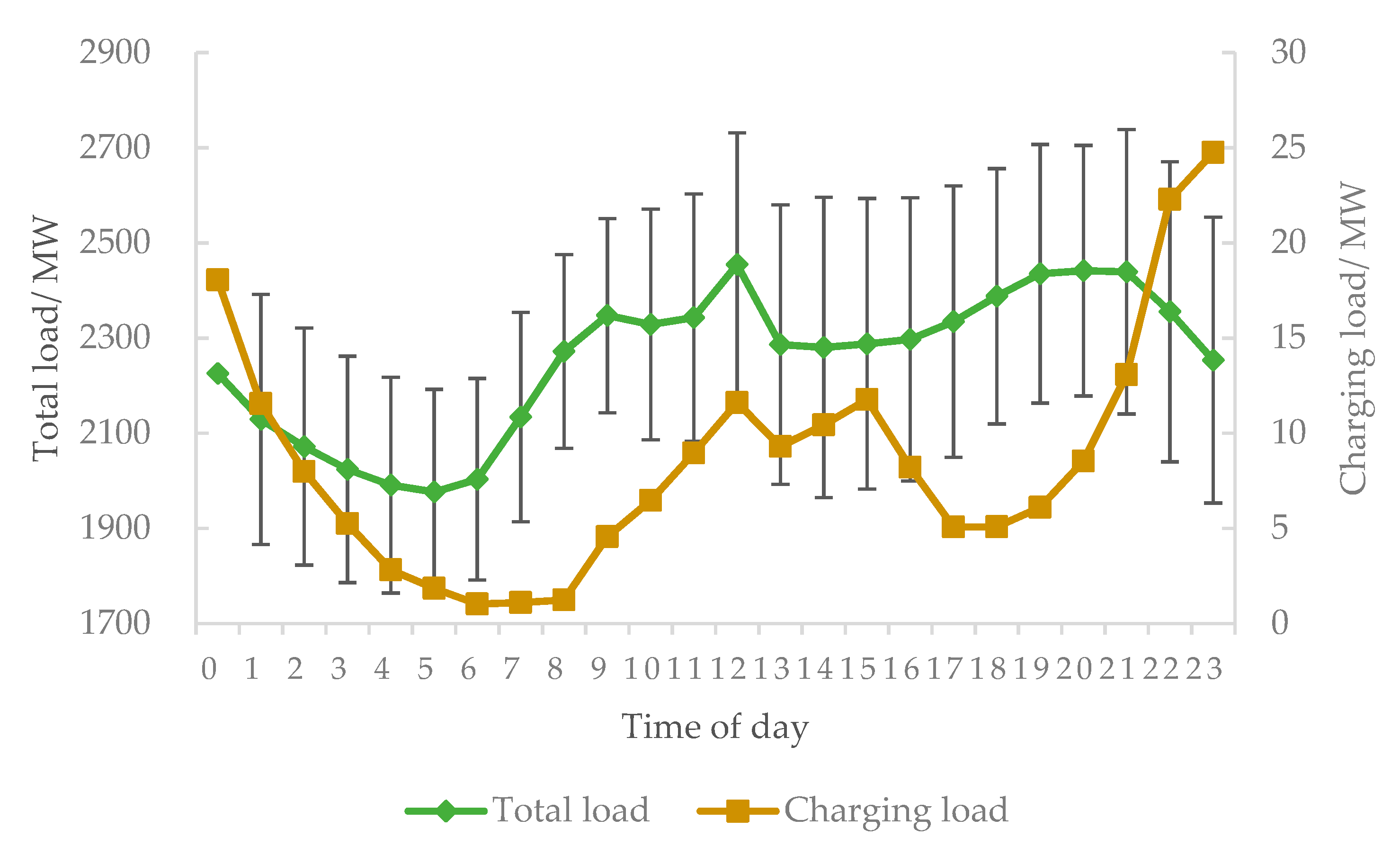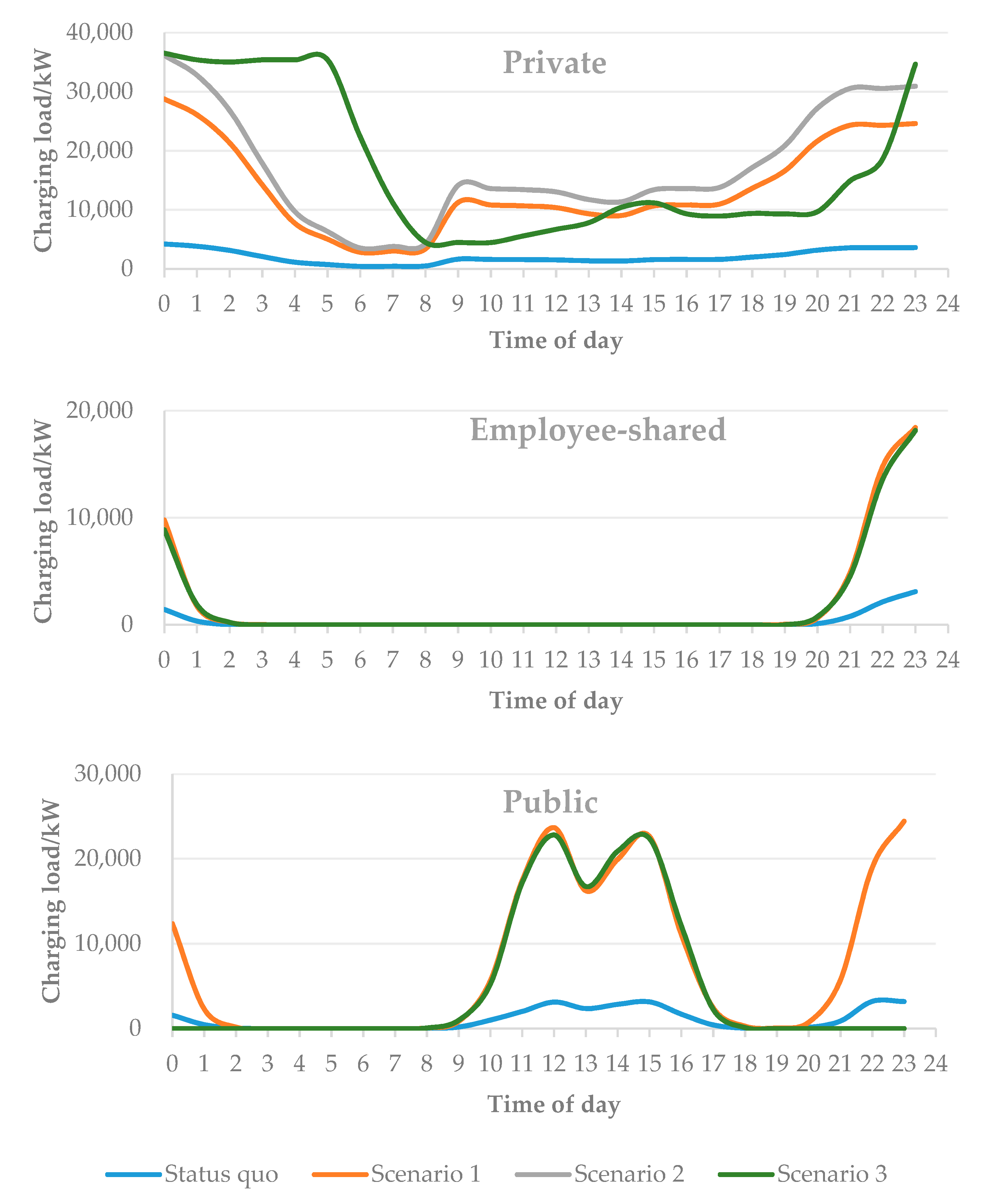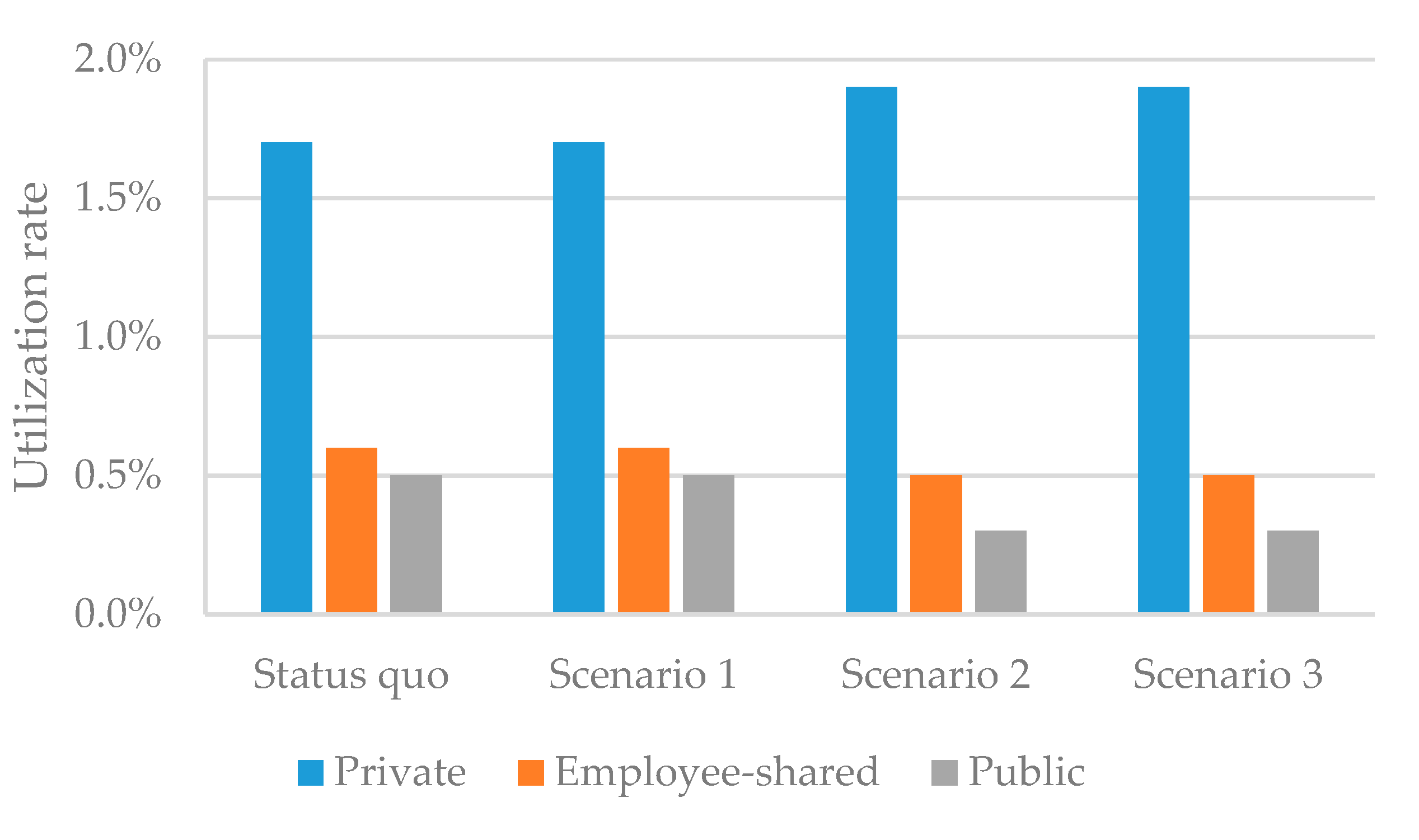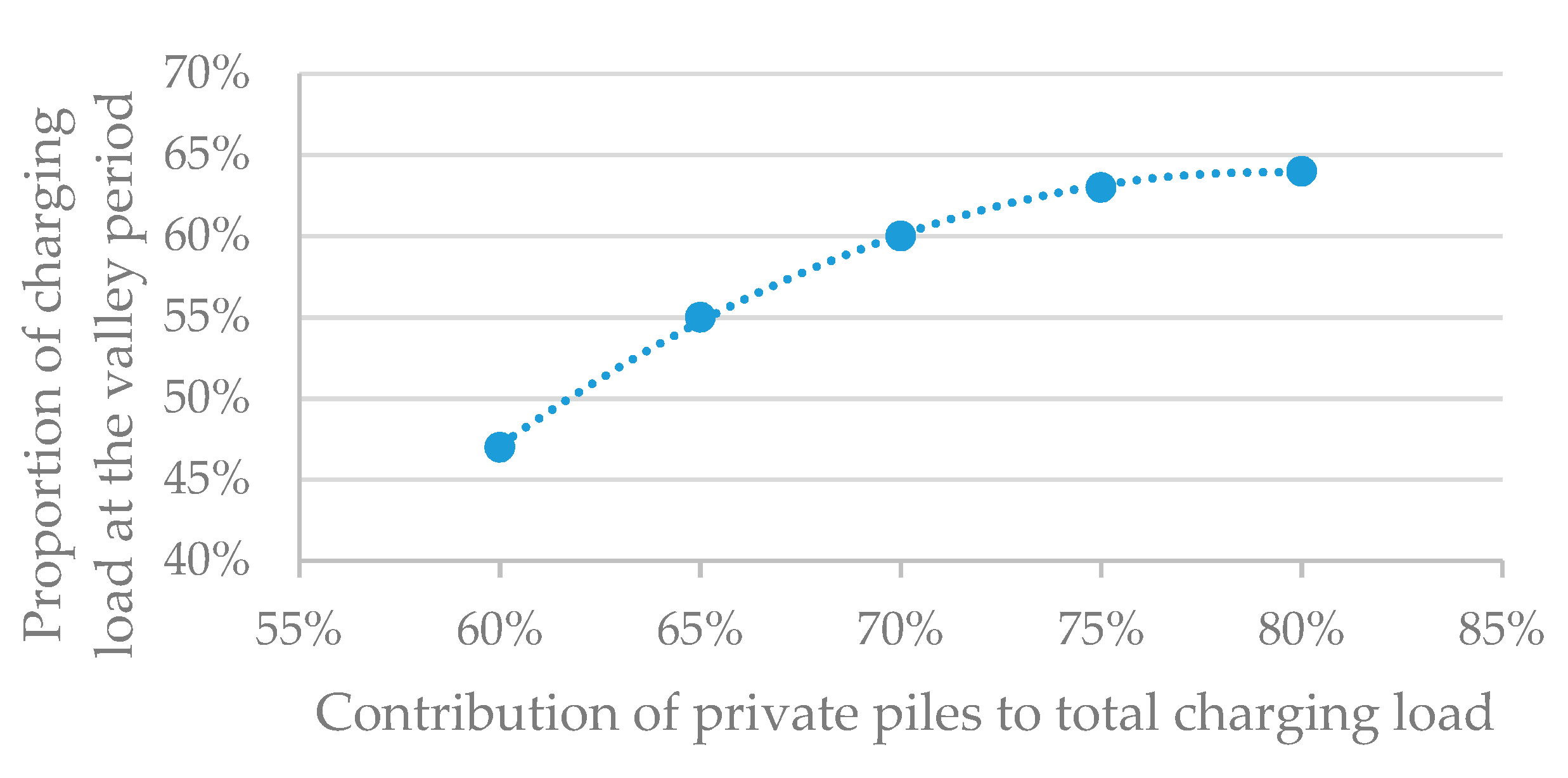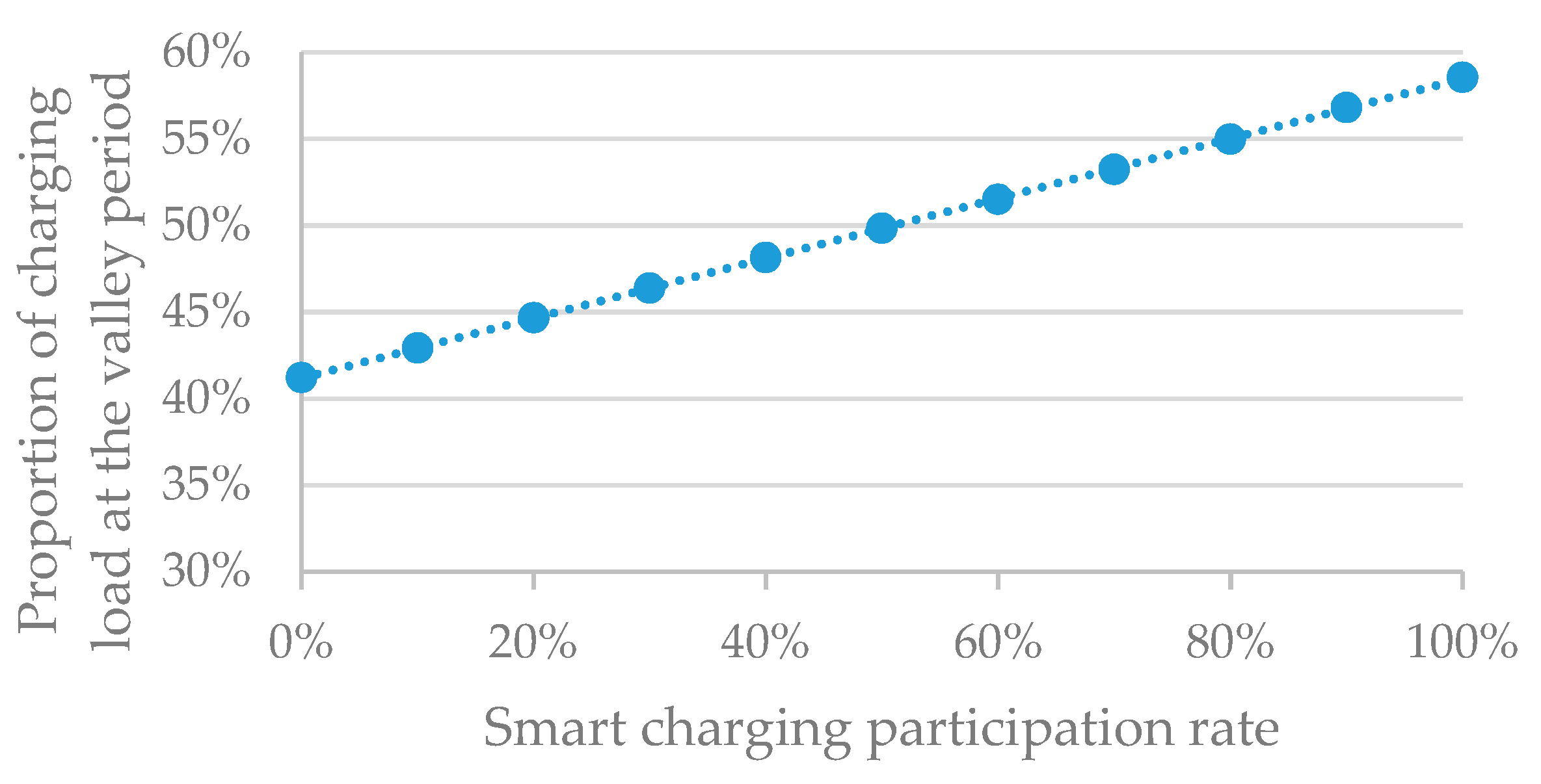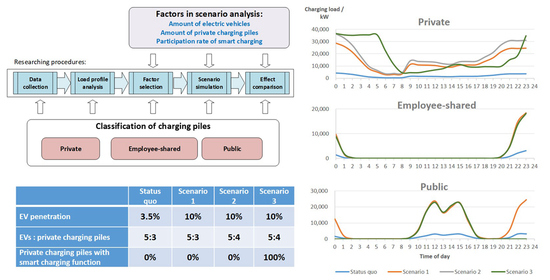1. Introduction
The transport sector is one of the key drivers of energy consumption and CO
2 emissions growth around the world [
1]. In particular, the increase in road vehicles has brought about serious environmental and energy problems. Many countries are actively exploring a combination of clean energy and road transportation electrification. Compared with traditional fuel vehicles, electric vehicles (EVs) take advantage of lower energy consumption costs and more environmentally friendly features [
2]. Promoting the use of EVs is an effective way to deal with road traffic pollution and global climate change [
3]. In recent years, driven by government policies and investment from auto manufacturers, China’s EVs and supporting infrastructure have developed rapidly [
4]. From 2015 to 2019, the number of EVs in China increased from 0.33 to 3.81 million [
5]. The average growth rate of EVs was 263.6% in the period, representing a steady and rapid growth. At the end of 2019, the number of charging piles in China reached 1.22 million, increasing the vehicle:pile ratio to 3.1:1. Of that total, about 42% were public charging piles and 58% were private ones [
6]. At present, promoting investment in the development of charging piles is plagued by several issues. First, uneven spatial distribution makes it difficult for EV drivers to find charging piles, especially in small- and medium-sized cities and rural areas. Second, the utilization rate of public charging piles is as low as 2% on average, which makes them unprofitable. Third, the required investment in power infrastructure for charging is ambiguous as the total and distributed charging load profiles are difficult to predict.
There have been many studies focusing on the challenges posed by EVs and charging infrastructure to the operation of the power grid. On the one hand, the adoption of electric vehicles (EVs) will have a direct impact on the electricity grids, mainly due to the additional power demand during current peak hours on the grid [
7]. Some old regional power grids may not be able to sustain the charging load of EVs due to a limited supply capacity, especially during peak charging periods [
8,
9]. By coordinating the charging and discharging of EVs and providing auxiliary power services, the operation of the power grid can be improved [
10,
11]. On the other hand, the investment in charging infrastructure is too high to be recovered due to a very low utilization rate of charging piles. There is great potential for cost savings for future investment if the spatial distribution and charging schedule can be optimized [
12]. Moreover, the dynamic evolution of private charging piles and public charging piles produces great uncertainty about future investments. Scientific prediction of EV charging demand is the basis for rational planning and the construction of charging infrastructure.
Some crucial factors should be considered in the planning, construction, and operation of charging piles. First, traffic flow [
13,
14] and areas’ function [
15] are important to select charging station sites to meet the charging demands of EVs when driving. Second, drivers’ charging behaviors, as well as key factors, such as the accessibility and crowdedness of charging piles, EV types and performances, electrovalence policy [
16,
17], and smart energy management systems [
18,
19], will contribute to shaping the charging load profile [
20,
21]. Against the backdrop of the large-scale use of EVs in the future, optimal adjustment of charging loads will be beneficial to the safety and efficiency of power grid operation [
8,
22]. The temporal characteristics and determinants of EV charging loads are important to consider. Third, the optimization of the distribution network with a combination of charging load adjustments will make a great contribution to cost savings and efficiency improvement as a whole, as proven by several optimization and application studies [
23,
24]. Based on the immediate and long-term considerations, prediction and scenario analysis of regional and urban charging load is important to guide power grid operation and load optimal adjustment, as well as the decision making of charging pile investment and site selection, by identifying key factors.
Research methods are mainly divided into simulation analysis, behavior analysis, and statistical analysis. (1) Simulation analysis is a method of calculation based on the probability of scene changes. Most scholars simulate the travel situation according to the user’s travel rules, and then compare the simulation results with the actual results. Monte Carlo is a widely used method for simulation [
25,
26]. (2) Behavioral analysis involves scholars analyzing the travel characteristics of users or vehicles in a certain time or space, and then using this to build a model of corresponding characteristics, such as a travel chain [
27,
28], Markov chain [
29,
30], agent-based model [
31], etc. (3) Statistical analysis refers to the use of traditional methods such as mathematical statistics and probability estimation to analyze historical data and predict the future. Cluster analysis of classified traffic patterns based on big data is employed to predict EVs’ charging demands [
32].
Studies of EV charging load prediction can be categorized into short-term ones and mid- to long-term ones [
33,
34]. Short-term load forecast methods are always used to predict the EV charging demands within a month [
35]. The mathematical methods applied are mainly divided into several clusters, for instance, probabilistic models [
36], diffusion theory [
37], support vector machine algorithms [
38], etc. In general, the EV adoption remains unchanged in such studies. The mid- and long-term load forecasting methods are devoted to the EV charging demand prediction for the next few years or for some time in the future. It is highly likely that EV adoption will see a remarkable increase in future scenarios. It can be seen from the above literature review that scholars’ research on EVs’ charging demand and load profile covers various factors, but there are still some limitations. (1) Due to the lack of Chinese EV data, many studies about China had to use data from the National Household Trip Survey (NHTS) of the United States. However, Chinese users’ behavior is different from Americans’, so there will be some deviations. (2) Scholars focused on the micro factors (such as price, traffic conditions, etc.) in all of the possible influencing factors; only a few scholars consider the impacts of an increased number of EVs on the charging demand, which is as important as the micro factors since EV penetration is growing rapidly in many Chinese cities. (3) The growing number of private charging piles has reduced the profit margin of public charging piles, and private ones are more conducive to smart charging. The impacts of increasing private piles and smart charging on the charging load profile are not clear. Therefore, this study aims to examine the impacts of EV amount, as well as increasing private charging piles and the popularity of smart charging technology on the charging load profile, based on a scenario analysis. Using the actual data of EV charging in Hefei, a typical city in China, this study will build different future scenarios based on separate analyses of three types of charging piles: public, employee-shared, and private. The future scenarios are simulated based on real-world traffic volume and actual charging data from Hefei. Furthermore, the results of scenario comparison will help identify key factors for peak-load shifting of EVs and provide references for future development of charging piles.
3. Results
3.1. Status Quo of EV Usage and Charging
By filtering and processing the EV driving data, the distribution of the driving frequency of EVs at different times is obtained. With 10-min intervals, 24 h are divided into 144 time points, as shown in
Figure 4. The blue line represents the mean of driving frequency at each time point, and the orange part represent the error margin based on the standard deviation of observed value.
It can be seen from
Figure 4 that there are three peak travel points within a day, appearing around 8:00, 13:00, and 17:00. There are three peaks of travel, named the morning peak (MP), the noon peak (NP), and the evening peak (EP). The MP and EP are in line with people’s daily commuting. The NP can be attributed to traveling for lunch and for work after lunch.
We obtained the 24-h charging load curves of different types of piles by selecting and integrating the charging pile data. The status quo of the charging load profile in Hefei is illustrated in
Figure 5 and
Figure 6. Charging demand is generated from 1 to 25 MW at each time within one day, which is 0.38% of the total load at average. Among them, private charging piles contribute 59% of the total demand, employee-shared piles account for 10%, and public ones account for 31%.
The charging load curves in
Figure 5 show different temporal characteristics. The charging load of private ones presents a wide distribution and slow gradient, which means some EVs are on charge at any time throughout the day. As most of private charging piles are low power, this prolongs the charging time and increases the charging frequency. In order to make full use of the valley price and save money, users will choose to charge the EV at night after a day’s journey. The charging load of employee-shared ones is concentrated at 21:00–01:00, presenting a large peak and rapid change. The load rises rapidly and then quickly falls in a short time. The load of public piles is concentrated at 10:00–17:00 and 21:00–01:00, which are the two peaks during working hours and before midnight. As most of the public charging piles are fast ones, the charging time of an EV is as short as 2 h. The load change indicates that the charging habits of users are different. Some users tend to charge when they are at work in the morning and afternoon, while some choose to charge at night. Therefore, the structural adjustment of charging piles and charging demand will affect the gross charging load profile.
The temporal distribution of EV charging load and the average load of Hefei are shown in
Figure 6. In general, the charging load presents a wavy distribution. Its minimum appears around 6:00 and its maximum at 23:00. After the residents finish their one-day trip, the EV will be charged at night, so the charging demand starts to increase after nightfall. Based on the comparison of the two curves in
Figure 6, the peaks and valleys of the two coincide most of the time except 16:00–23:00. This shows that the disordered charging of EVs will increase the burden of the power grid around noon and in the evening.
3.2. Charging Load Profiles in Different Scenarios
Assuming that all EVs have the same parameters as the prototype vehicle collected, each scenario is simulated based on realistic data and fixed parameters. The charging load at each time is calculated for different types of charging piles, and then superimposed together. The charging load of each time is only related to the number of EVs charging, while the variation of charging power is not considered.
The results of simulation are presented in this section.
Figure 7 shows the change of charging load of each type in different scenarios. The load of private piles in each period increases significantly when the penetration rate increases. In Scenarios 1 and 2, the users are charged randomly, so the charging rules are the same. The charging load of private piles is distributed throughout the day, with the peak appearing at 21:00 and the low appearing at 6:00. In Scenario 2, the number of private charging piles is greater than that in Scenario 1, so the charging load at each time is slightly larger. After the implementation of smart charging, the charging load in the evening is significantly reduced, while the charging load from 22:00 to 06:00 is significantly increased. The peak load is postponed from 21:00 to midnight and early morning, which effectively promotes power use in the valley, and reduces the peak of Hefei’s total load. Therefore, smart charging will mitigate the impacts of EV charging on the grid.
Compared with the status quo, the employee-shared piles show the characteristics of conventional charging in the case of increased EV penetration. The temporal distribution of charging load remain stable when other conditions change, but the charging load peak during 21:00–01:00 will increase in all scenarios.
The charging curves of public piles in status quo and Scenario 1 show a clear gap in that the peaks are intensified in the daytime and at night. The disappearance of the peak load at night in Scenarios 2 and 3 indicates that the charging load of public piles has been shifted. When the adoption of private charging piles increases, EV charging at public piles will be transferred to charging at home. Moreover, smart charging will promote the transfer. However, the peak during 11:00–16:00 is not changed or transferred as the charging service is for EVs on the road and is an urgent need.
In general, without changing the other conditions, the increase in the EV amount will only increase the original load but will not change the charging habits of the driver (from the status quo to Scenario 1). When the number of private charging piles increases, the charging load of public piles will be transferred to private ones (from Scenario 1 to Scenario 2). After users are willing to participate in smart charging, the charging load peak in the evening will move to midnight and early morning to fill the electric valley at night in Hefei (from Scenario 2 to Scenario 3).
3.3. Parameter Comparison of Different Scenarios
Table 2 compares some key parameters of simulation results of status quo and three scenarios. Charging piles in Scenario 1 provided an accumulated charging load (A.L. in
Table 2) of 567 MW at 24 time points in a day. Compared with the status quo, the load of each type increased greatly, but the proportion remained stable. In Scenario 1, EVs’ charging load is superimposed with the original load as the penetration rate increases, which will threaten the stability of the grid. The starting time and duration of charging will not change if the charging habits of the users do not change. The increase in the number of EVs will directly lead to a further increase in the peak load of the local grid.
Charging piles in Scenario 2 provide an accumulated charging load of 586 MW at 24 time points in a day, which is close to that in Scenario 1. However, the contribution of private piles increases from 59% to 71% (P in
Table 2). The structural change of charging piles indicates that there is a significant peak-load shifting. Comparing Scenarios 1 and 2, we see that increasing the adoption rate of private charging piles has no significant effect on the total load but will shift a great part of the public charging load to a private charging load. According to the simulation, 12% of the charging load will be shifted from public piles to private ones if the ratio of EVs and private piles increases to 5:4. The private charging load is characterized by a wide distribution and gentle slope, while the public charging load is characterized by large peaks and rapid changes. Therefore, it is beneficial for peak-load shifting if the EV users change their demand from public piles to private ones. However, the peak-load shifting from 08:00–22:00 to 22:00‒08:00 is not significant.
Comparing Scenarios 2 and 3 reveals that increasing smart charging application will transfer 18% of the charging load from 08:00–22:00 to 22:00–08:00. The transfer means that most (59%) of the charging load can benefit from the low power price in the period of valley load.
The utilization rates of charging piles in different scenarios are calculated with the assumption that the number of piles will increase with the increasing number of EVs. The results are shown in
Figure 8. In all cases, the utilization rate of public charging piles is lower than that of employee-shared ones, and the utilization rate of private piles is the highest in the three types. This may be because the users of employee-shared and private piles are relatively fixed. Compared with the status quo, the utilization rate of charging piles in Scenario 1 does not change significantly. In Scenarios 2 and 3, the utilization rate of public charging piles will decrease from 0.5% to 0.3% due to peak-load shifting. At the same time, the utilization rate of private charging piles will increase from 1.7% to 1.9%.
3.4. Sensitivity Analysis
Based on the simulation analysis, the structural variation of charging piles and smart charging participation will affect the drivers’ charging behaviors and starting times, consequently changing the charging load. In this section, we explore the sensitivity of the results to variations in some key factors.
The influence of increasing private charging piles on charging load is explored in Scenario 3 with smart charging. The model is simulated with the contribution of private charging piles to total charging load from 60% to 80% at 5% intervals. The accumulated charging load is unchanged but the proportion of charging load at the valley period (22:00–08:00) will increase, as shown in
Figure 9. This variation indicates that load shift can be promoted by increasing the number of private charging piles.
With the improvement of the charging system, smart charging is bound to become the major charging technology. We further explore the impact of smart charging participation rate on charging load, with the participation rate changing from 0 to 100% at 10% intervals. As shown in
Figure 10, increasing the smart charging participation rate will increase the proportion of the charging load at the valley period (22:00‒08:00), with a linear relationship. The results also indicate that the charging load by day cannot be compressed to 0, as some drivers will use charging piles for charging during daytime journeys.
As can be seen in
Figure 9 and
Figure 10, increasing the proportion of charging load from private charging piles and the smart charging participation rate can promote charging load shifting to valley periods, but the effects and limitations of the two are different. The contribution of increasing private charging piles is significant in the first stage but limited after a certain threshold, which means that some rigid charging demands in the daytime and evening cannot be transferred. For the same reason, increasing participation in smart charging has a limitation for charging load shift, which may be correlated with the input parameters in the model. In general, the results indicate that both of the factors contribute to charging load shifting, but their limitations cannot be overlooked. On the other hand, public and employee-shared piles are also necessary in the future.
EVs’ continued voyage course (CVC) may be a factor with great growth potential in the future, which will increase with the development of battery technology. CVC will possibly affect drivers’ concerns about endurance, as well as their charging behaviors. Specifically, the charging frequency will drop with the increase in CVC, with a nonlinear relationship. However, we find that the impacts of CVC variation on gross charging load profile are very limited when we change the CVC from 200 to 800 km, as the travel habits of drivers are relatively fixed on weekdays. Under the influence of increasing private piles and smart charging technology, the total charging load of the city has not changed significantly. In addition, increasing CVC will not change the status quo of the low utilization rate of public charging piles.
4. Discussion
4.1. Contributions
This study makes novel contributions in the following aspects. First, the status quo and future scenarios are analyzed based on actual monitoring data from Hefei. The EV penetration rate and the decision function of EV users are included in the model to forecast charging load of EVs. Second, the structural evolution of charging piles is selected and proved to be an important factor in the EV charging load. Among three types of charging piles, this study mainly studies the influence of increasing private charging piles on charging load. Third, the influence of smart charging adoption on charging load is analyzed in a future scenario. Through the comparison of simulation results, this paper verifies the feasibility of peak-load shifting by private pile promotion and smart charging.
Previous studies have assumed that EVs will only be charged at staged destinations when SOC is not satisfied with the next trip or when the users feel range anxiety [
43,
44]. Although this assumption is consistent with multisegment or long-distance travel on holidays, it does not apply to the travel on workdays in China due to users’ stable travel behaviors. Through the data processing, we found that the average charging frequency of most EVs in Hefei is less than 1 per day, indicating that the EV battery can at least meet the daily travel demand of users. Therefore, users’ travel habits are relatively fixed on weekdays in China, and the private charging piles might have a greater influence than public ones on charging load profiles. With the assumption of constant charging behaviors of EVs’ users, we focus on forecasting the charging profiles under scenarios with a large number of private charging piles, which is different from previous studies.
4.2. Limitations
This study mainly studies the charging load profile on workdays, but neglects those during weekends and holidays, which is the primary limitation. On weekdays, users’ travel behavior is relatively fixed, so the charging behavior also tends to be fixed, and the daily charging amount is also stable. On weekends or holidays, users’ charging behavior will change and have a certain impact on the results. In the future, further studies can be conducted to explore the temporal-spatial distribution of charging demand on weekends and holidays and compare them with workdays. In addition, we define individual charging preferences from the perspective of the overall charging behavior of users, without considering the impacts of price and convenience on individuals. These individual-level factors may be included in future research.
4.3. Suggestions
As stated in the Introduction, the optimization of the distribution network in combination with charging load adjustment will make a great contribution to cost savings and efficiency as a whole. The study lays the foundation for the optimal configuration of EV charging infrastructure. According to the simulated results, it is suggested that private and public charging piles around residence zones should be encouraged, as they hold great potential to provide a smart charging service. Public and employee-shared charging piles’ site selection should be optimized according to the traffic flows and actual demand, to improve the average utilization rate. Besides, the growth potential of private piles should be considered when assess and predict the demand for public charging piles.
Moreover, as one of the significant tools peak-load shifting, smart or intelligent charging technology is still in its infancy with a very limited number of users. In order to promote the adoption of smart charging technology, a series of supporting policies are necessary, such as promoting reform of the electricity price mechanism, building an electricity market trading system, and providing fiscal subsidies for adoptions.
5. Conclusions
Understanding the temporal-spatial features of EV charging loads in a region or city is crucial to optimizing the configuration of charging infrastructure and satisfying users. This study proposes an analysis of the impacts of increasing private charging piles and smart charging adoption on EVs’ charging load profile, in which scenario analysis and Monte Carlo simulation are employed. Some conclusions can be drawn.
(1) The charging load profiles of different types of charging piles show different temporal characteristics. That of private piles is widely distributed with a gentle slope and a long peak in the evening, while that of public piles has two peaks, during working hours and before midnight. Therefore, the structural adjustment of charging piles and charging demand will affect the gross charging load profile.
(2) In future, the increasing number of EVs will increase the load on the local grid. Promoting the adoption of private charging piles will hardly affect the accumulated charging power but will transfer the charging load from public piles to private ones. Due to the different load profiles of the two charging piles, the charging peak will be weakened by day but enhanced at night.
(3) The simulated results indicate that promoting the adoption of private piles and smart charging technology will achieve a peak-load shifting effect. However, these changes will possibly reduce the utilization rate of public charging piles. Urban governments should consider the growth potential of private piles and promote smart charging in charging infrastructure planning.
